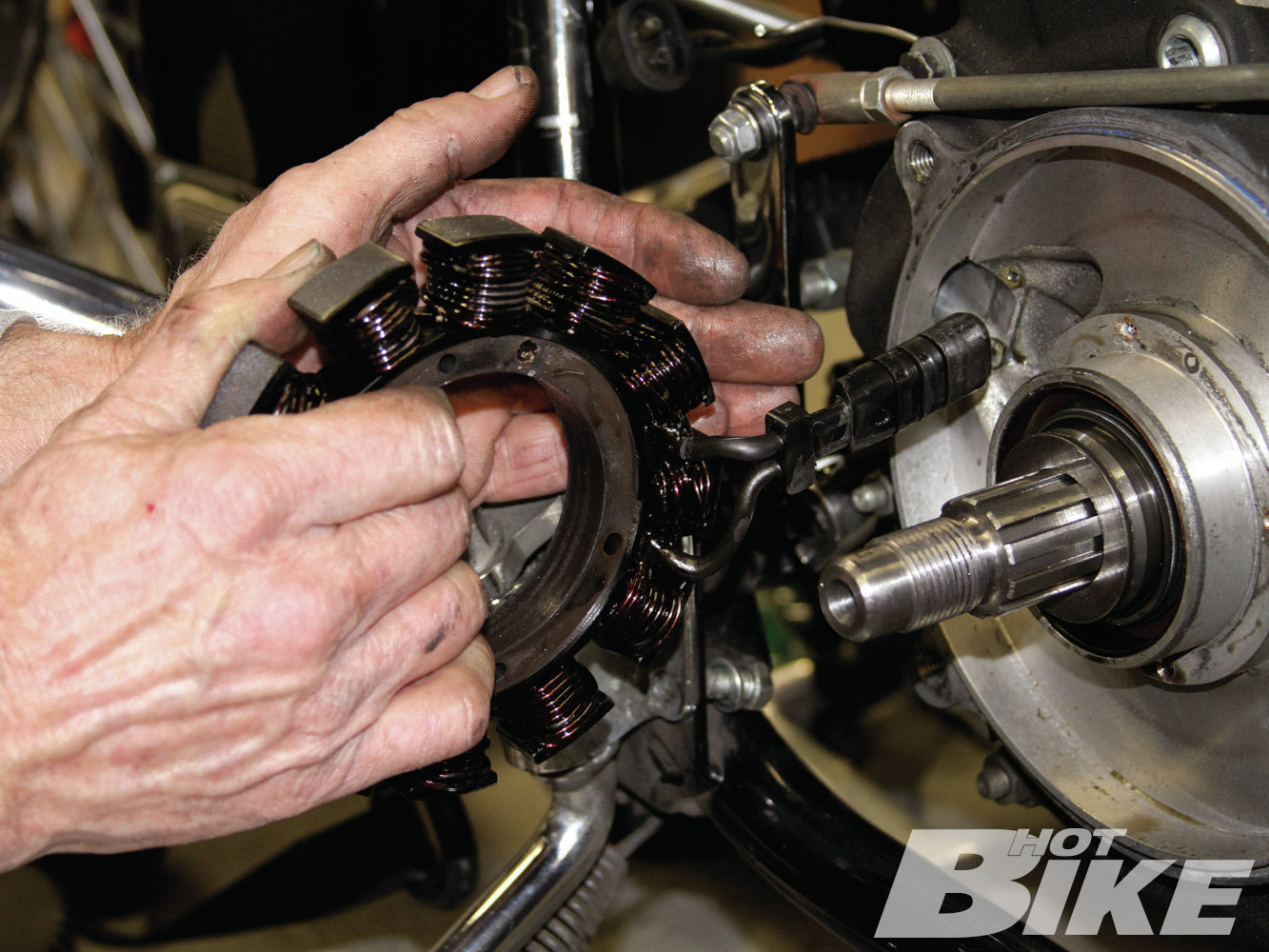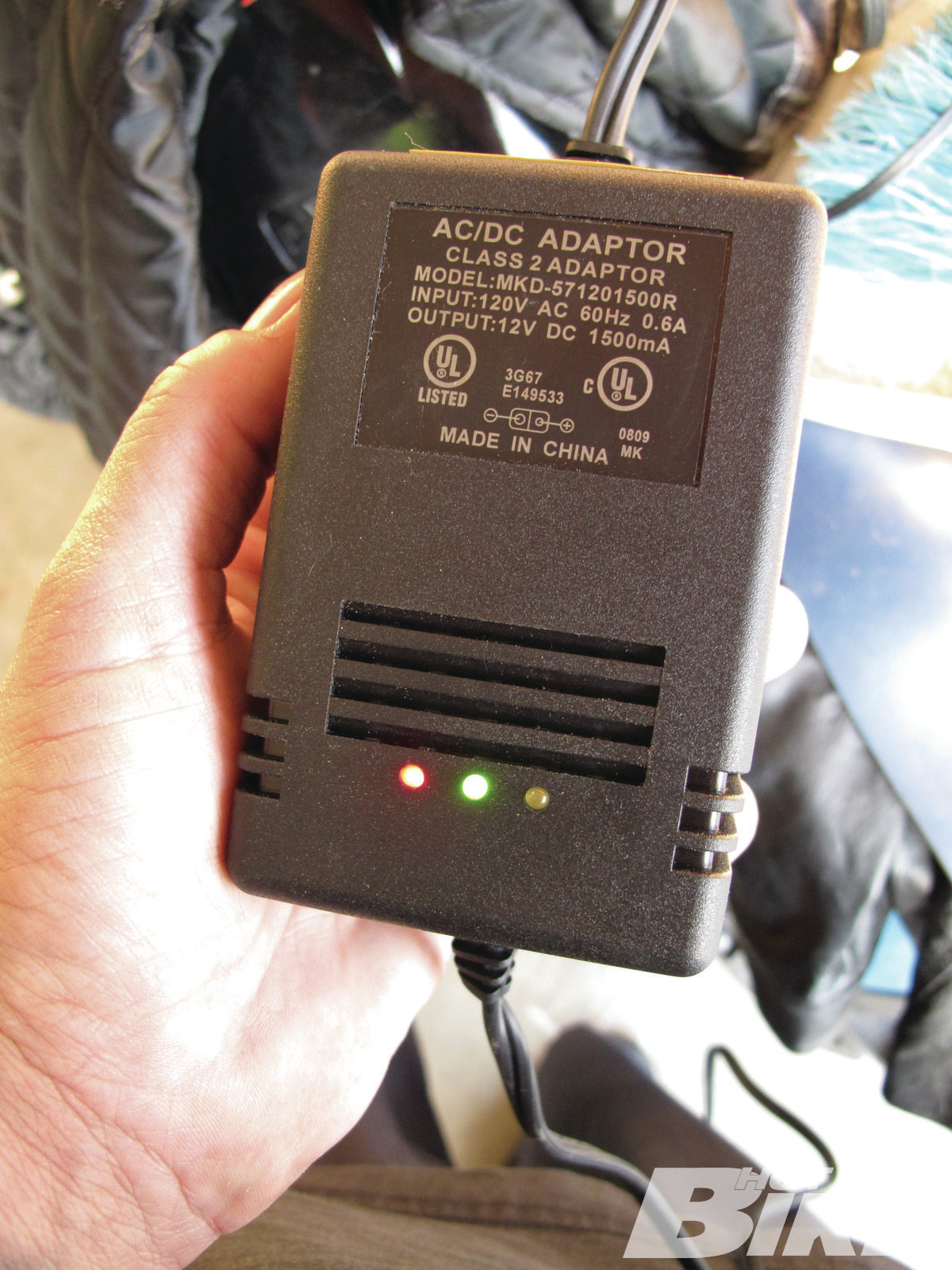Re-Charged Road King | Charging System Basics



01. Pictured is the new stator, voltage regulator, and circuit breaker. These three components, along with the rotor and battery, make up the bike’s charging system. Notice the plug from the stator. It carries the 30-40 volts of AC power to the voltage regulator’s pronged plug, which is then converted to 14.2 volts of DC power. Ray said the circuit breaker was shot too, so he installed a new one.



02. Along with the J&P; Cycles Sealed High Output battery we also ordered a J&P; Cycles Large 1.5 Amp Charger ($47.99) to maintain the battery when not in use. This unit manages the battery’s voltage while the bike sits for periods of time, but won’t overcharge because it automatically switches to standby mode when the battery reaches a full charge.

05. Getting to the stator required removing the entire primary (outer cover and inner primary). Once that was completed, Ray removed the magnetic rotor that covers the stator. The rotor’s magnets rotate around the stator to excite the stator’s coils, which generates AC voltage.

06. Out with the old…

07. …in with the new. Once the stator was slid onto the sprocket shaft, the stator plug was routed through the engine case to be hooked up to the new voltage regulator.

08. The rotor was re-installed using two flathead screwdrivers because the force of the magnets is so strong it needs to be restrained so it doesn’t slam against the stator, etc.

09. Ray ditched the old voltage regulator and hooked up the new one between the frame’s downtubes.

10. He then routed the voltage regulator’s male plug to the stator’s female port and plugged the two together. Notice the equal length of the two prongs (arrow), nice and healthy. Next, Ray hooked up the old regulator’s ground wire to the new regulator and routed it to the chassis to ground it.

11. Ray then routed the regulator’s positive cable (A) to the circuit breaker’s silver post. The red cable with black sleeve (B) was routed to the ignition. Lastly, the black cable with red sleeve was hooked up to the copper post (C) and routed to the starter where it meets the battery’s positive cable. The circuit breaker acts just like your home’s circuit breaker. If you’re running too many accessories on your bike, it protects your battery from being overloaded.

12. Last to be installed was J&P; Cycles’ new Sealed High Output battery. J&P; offers a wide variety of batteries that are model-specific. After hooking up the positive cable first (always!), he connected the ground cable. The J&P; Cycles charger’s blue and red cables were then hooked up to the battery.

13. It was then routed under the frame next to the right side cover and plugged into the J&P; charger.

14. As you can see, the green light showed that the battery was good to go and the charging system was working properly. And with that, the charging system install was completed.
After freshening up the top end of our project ’96 Road King, the engine was running tip-top, but the charging system was starting to crap out. The charging system is generally made up of the stator, rotor, and voltage regulator. All of that, along with the battery, is responsible for starting the bike and keeping it running, operating the lights, turn signals, and accessories, and keeping the battery charged. And you thought parenting was a lot of work.
The stator is a stationary unit that is comprised of tightly wound bunches of copper wiring wrapped around a circular housing that installs on the crankshaft’s sprocket shaft. The rotor is the yin to the stator’s yang. It’s a circular steel housing fitted with rare-earth magnets that encase the stator and also installs on the sprocket shaft. The rotor’s magnets spin around the stator via the sprocket shaft exciting the copper wires, ultimately producing about 30-40 volts of AC power. The voltage regulator then converts the 30-40 volts of AC power to about 14.2 volts of DC power.
The first step for checking the charging system is to check the battery with a multimeter, which measures voltage, current, and resistance. An analog multimeter can be had for around $20 at most auto parts stores, and we’ve seen digital multimeters for less than $100. You’ll also need the multimeter for checking the stator and voltage regulator so it’s best to just pony up and get one.
We dropped the bike off at Anaheim-Fullerton Harley-Davidson so technician Ray Colbeth could give the charging system a look-see. Ray checked the ’96 Road King with a multimeter, and what he found wasn’t good. We needed a brand-new H-D stator ($119.99), H-D voltage regulator ($99.99), and H-D circuit breaker ($7.99). The King also needed a new battery, so a J&P Cycles Sealed High Output battery was ordered ($109.99). HB
Source:
Anaheim-Fullerton Harley-Davidson
(714) 871-6563 | harleyfullerton.com
J&P; Cycles
(800) 318-4823 |jpcycles.com







